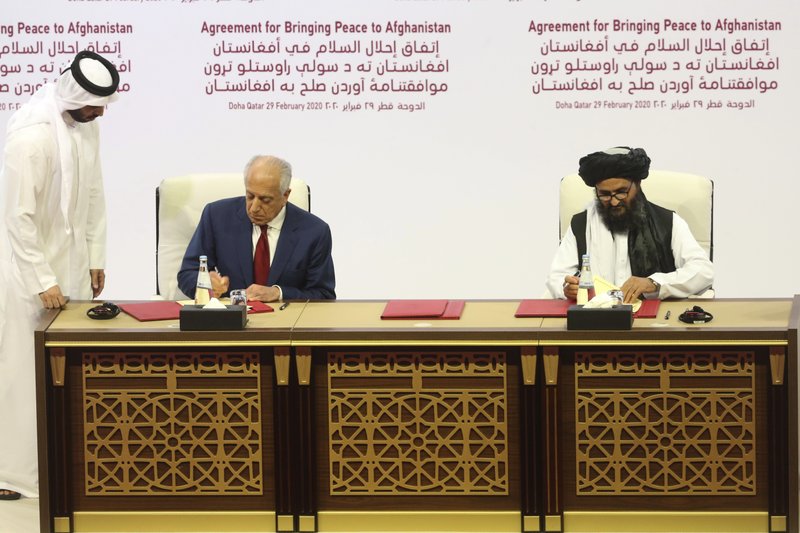KABUL, Afghanistan -- The former Soviet Union marched into Afghanistan on Christmas Eve, 1979, claiming it was invited by the new Afghan communist leader, Babrak Karmal, setting the country on a path of 40 years of seemingly endless wars and conflict.
More than 5 million Afghans fled to Pakistan and 3 million to Iran after 1980, and today, Afghans still make up the world's second-largest refugee population. After the 9/11 terrorist attacks in America, the U.S. invaded Afghanistan to oust the Taliban regime, which had harbored al-Qaida leader Osama bin Laden.
Here is a timeline of some key dates in Afghanistan's 40 years of wars:
Dec. 25, 1979 -- Soviet Red Army crosses the Oxus River into Afghanistan. In neighboring Pakistan, Afghan mujahedeen, or Islamic holy warriors, are assembling, armed and financed by the U.S. for an anti-communist war.
1980s -- The CIA's covert Operation Cyclone funnels weapons and money for the war through Pakistani dictator Mohammed Zia-ul Haq, who calls on Muslim countries to send volunteers to fight in Afghanistan. Osama bin Laden is among the thousands to volunteer.
1983 -- President Ronald Reagan meets with mujahedeen leaders, calling them freedom fighters.
September 1986 -- The U.S. provides the mujahedeen with anti-aircraft Stinger missiles, which turned around the course of the war and sped-up negotiated Soviet withdrawal.
January 1987 -- Afghanistan's communist president, Mohammad Najibullah, starts a program to encourage the mujahedeen to join a new government of national reconciliation; they refuse.
Feb. 15, 1989 -- The last Soviet soldier leaves Afghanistan, ending 10 years of occupation
April 1992 -- Mujahedeen groups enter Kabul as Najibullah tries to flee. He is stopped at the airport and put under house arrest at a U.N. compound.
1992-1996 -- A power-sharing deal among seven mujahedeen leaders falls apart and they spend four years fighting one another; much of Kabul is destroyed and nearly 50,000 people are killed.
1994 -- The Taliban emerge in southern Kandahar, mainly from the ranks of former mujahedeen fighters. They take over the province, setting up a rule adhering to a strict interpretation of Islam.
Sept. 26, 1996 -- The Taliban take Kabul after sweeping across the country with hardly a fight; the Northern Alliance's Tajik leader Ahmed Shah Masood and his forces retreat north toward the Panjshir Valley. The Taliban hang Najibullah and his brother.
1996-2001 -- The Taliban rule with a heavy hand under Mullah Mohammed Omar, imposing strict Islamic edicts, denying women the right to work and girls the right to go to school. Punishments and executions are carried out in public.
2000 -- The Taliban eradicate opium production, but laborers who lived off the poppy fields become even poorer.
March 2001 -- The Taliban dynamite the world's largest standing Buddha statues in Bamyan province.
Sept. 9, 2001 -- Two Arab-speaking suicide bombers, posing as journalists with Belgium passports, kill Masood in northern Takhar province, two days before the 9/11 terrorist attacks.
September 2001 -- Washington gives Mullah Omar an ultimatum: hand over bin Laden and dismantle militant training camps or prepare to be attacked. The Taliban leader refuses.
Oct. 7, 2001 -- A U.S.-led coalition invades Afghanistan.
Nov. 13, 2001 -- The Taliban flee Kabul for Kandahar as the U.S.-led coalition marches into the Afghan capital with the Northern Alliance.
Dec. 5, 2001 -- The Bonn Agreement is signed in Bonn, Germany, giving the majority of power to the Northern Alliance's key players and strengthening the warlords who had ruled between 1992 and 1996. Hamid Karzai, an ethnic Pashtun like most Taliban, is named president.
Dec. 7, 2001 -- Mullah Omar leaves Kandahar and the Taliban regime officially collapses.
Dec. 13, 2001 -- Karzai arrives in Kabul; contrary to the Bonn Agreement, militias loyal to warlords also enter the Afghan capital.
Dec. 22, 2001 -- Karzai is sworn in as chairman of a 29-member governing council established under the Bonn Agreement.
2004 and 2009 -- General elections are held and Karzai is elected president for two consecutive terms, the limit under the Afghan Constitution.
April 5, 2014 -- Deeply flawed election results in the two front-runners, Ashraf Ghani and Abdullah Abdullah, both claiming victory. Secretary of State John Kerry negotiates a power-sharing deal for a so-called unity government, with Ghani serving as president and Abdullah as chief executive.
Dec. 8, 2014 -- American and NATO troops formally end their combat mission, transitioning to a support and training role though President Barack Obama had authorized U.S. forces to carry out operations against Taliban and al-Qaida targets.
2015-2018 -- The Taliban surge further, staging near-daily attacks targeting Afghan and U.S. forces; scores of civilians die in the crossfire. An Islamic State group affiliate emerges in the east; the Taliban seize control of nearly half the country.
September 2018 -- President Donald Trump appoints veteran Afghan-American diplomat Zalmay Khalilzad as negotiator with the Taliban.
2018-2019 -- Zalmay engages in on-again, off-again talks with the Taliban. The Taliban refuse to negotiate with the Kabul government.
Sept. 9 -- After a particularly intense escalation in Taliban attacks, including a Kabul bombing that killed a U.S. soldier, Trump scraps talks with the Taliban.
Sept. 28 -- Presidential elections are held but official results are not known for months.
Nov. 24 -- Trump visits U.S. troops in Afghanistan on Thanksgiving, says the Taliban want to make a deal and signals the Qatar negotiations are back on.
Feb. 15 -- Washington says a temporary "reduction in violence" has been agreed upon with the Taliban as a first step toward a final peace deal.
Feb. 18 -- Afghanistan's election commission declares Ghani the official winner of September elections; his rival Abdullah refuses to recognize the results and instead declares himself the winner.
Feb. 29 -- The U.S. and the Taliban sign a deal in Doha, Qatar, laying out the withdrawal of U.S. troops from Afghanistan; the deal also envisions intra-Afghan talks on a future political road map.
A Section on 03/01/2020

